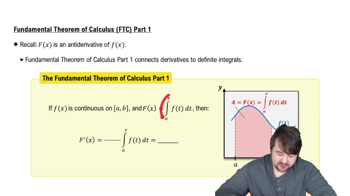Assume that y = 5x and dx/dt = 2. Find dy/dt
Table of contents
- 0. Functions7h 54m
- Introduction to Functions16m
- Piecewise Functions10m
- Properties of Functions9m
- Common Functions1h 8m
- Transformations5m
- Combining Functions27m
- Exponent rules32m
- Exponential Functions28m
- Logarithmic Functions24m
- Properties of Logarithms36m
- Exponential & Logarithmic Equations35m
- Introduction to Trigonometric Functions38m
- Graphs of Trigonometric Functions44m
- Trigonometric Identities47m
- Inverse Trigonometric Functions48m
- 1. Limits and Continuity2h 2m
- 2. Intro to Derivatives1h 33m
- 3. Techniques of Differentiation3h 18m
- 4. Applications of Derivatives2h 38m
- 5. Graphical Applications of Derivatives6h 2m
- 6. Derivatives of Inverse, Exponential, & Logarithmic Functions2h 37m
- 7. Antiderivatives & Indefinite Integrals1h 26m
- 8. Definite Integrals4h 44m
- 9. Graphical Applications of Integrals2h 27m
- 10. Physics Applications of Integrals 3h 16m
- 11. Integrals of Inverse, Exponential, & Logarithmic Functions2h 31m
- 12. Techniques of Integration7h 41m
- 13. Intro to Differential Equations2h 55m
- 14. Sequences & Series5h 36m
- 15. Power Series2h 19m
- 16. Parametric Equations & Polar Coordinates7h 58m
4. Applications of Derivatives
Related Rates
Problem 3.8.9
Textbook Question
If L = √(x² + y²), dx/dt = –1, and dy/dt = 3, find dL/dt when x = 5 and y = 12.
 Verified step by step guidance
Verified step by step guidance1
First, recognize that L is a function of x and y, specifically L = √(x² + y²). This is the formula for the length of the hypotenuse in a right triangle with legs x and y.
To find dL/dt, use implicit differentiation with respect to time t. Start by differentiating both sides of the equation L = √(x² + y²) with respect to t.
Apply the chain rule to differentiate L = √(x² + y²). The derivative of L with respect to t is (1/2) * (1/√(x² + y²)) * (2x * dx/dt + 2y * dy/dt).
Substitute the given values into the differentiated equation: dx/dt = -1, dy/dt = 3, x = 5, and y = 12.
Simplify the expression to find dL/dt. Remember to substitute the values into the expression and simplify step by step, ensuring each part of the equation is correctly calculated.
 Verified video answer for a similar problem:
Verified video answer for a similar problem:This video solution was recommended by our tutors as helpful for the problem above
Video duration:
4mPlay a video:
Was this helpful?
Key Concepts
Here are the essential concepts you must grasp in order to answer the question correctly.
Chain Rule
The chain rule is a fundamental principle in calculus used to differentiate composite functions. It states that if a variable z depends on y, which in turn depends on x, then the derivative of z with respect to x can be found by multiplying the derivative of z with respect to y by the derivative of y with respect to x. In this problem, it helps in finding dL/dt by relating the derivatives of L with respect to x and y.
Recommended video:

Intro to the Chain Rule
Implicit Differentiation
Implicit differentiation is a technique used to find the derivative of a function when it is not explicitly solved for one variable in terms of another. It is particularly useful when dealing with equations involving multiple variables. In this scenario, implicit differentiation allows us to differentiate L = √(x² + y²) with respect to time, t, by considering the derivatives dx/dt and dy/dt.
Recommended video:

Finding The Implicit Derivative
Pythagorean Theorem
The Pythagorean theorem is a geometric principle that relates the lengths of the sides of a right triangle. It states that the square of the hypotenuse (L) is equal to the sum of the squares of the other two sides (x and y). In this problem, L = √(x² + y²) represents the hypotenuse, and understanding this relationship is crucial for setting up the equation to find dL/dt.
Recommended video:

Fundamental Theorem of Calculus Part 1

 4:16m
4:16mWatch next
Master Intro To Related Rates with a bite sized video explanation from Patrick
Start learningRelated Videos
Related Practice
Textbook Question
